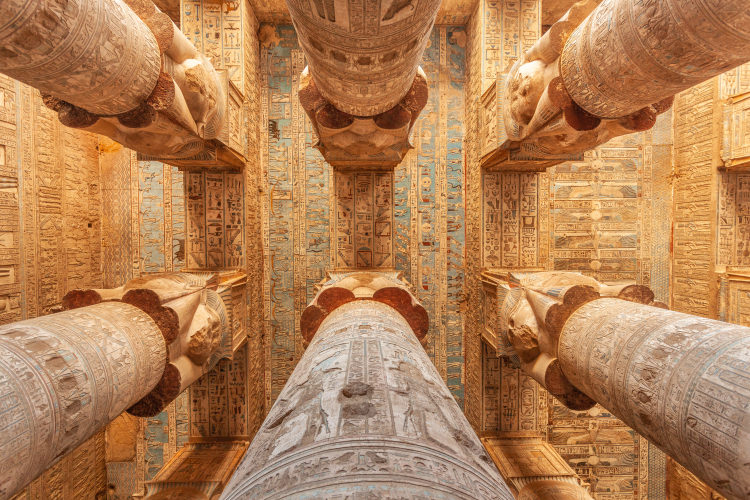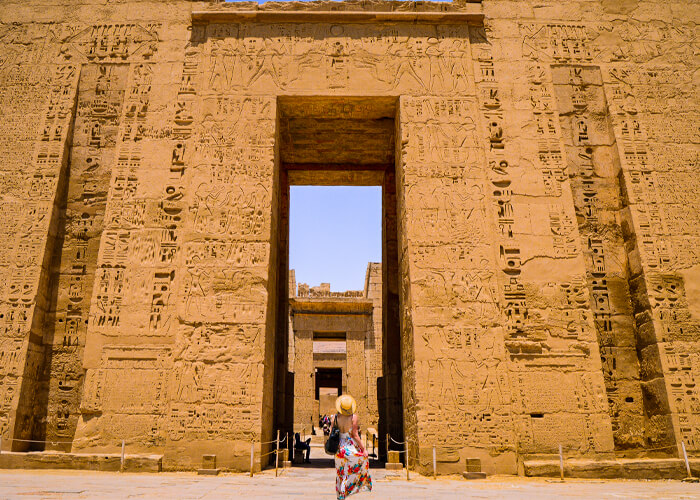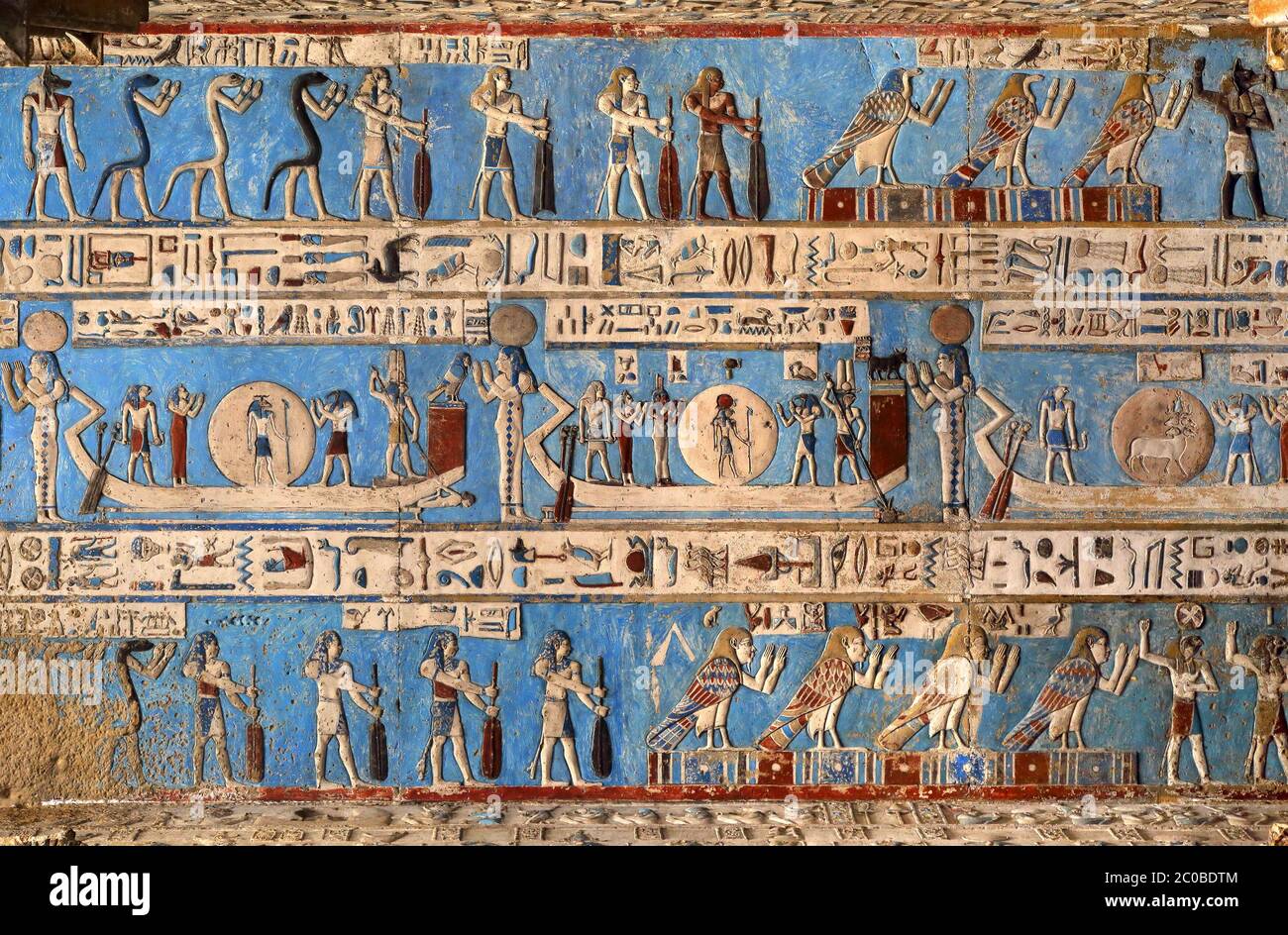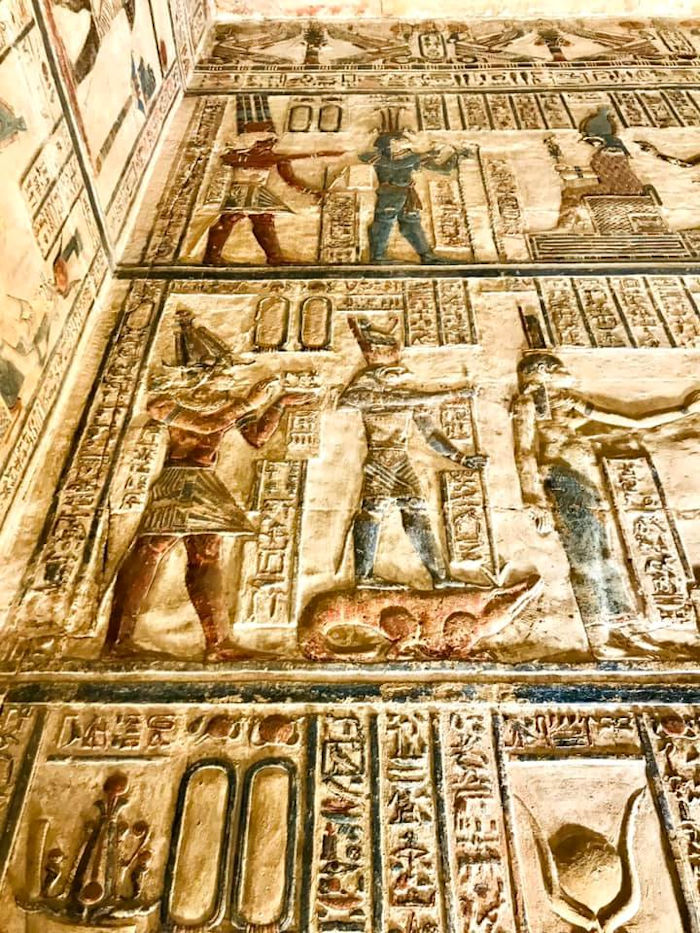Dendera Temple: A Timeless Testament to Ancient Egyptian Engineering

The Dendera Temple in Egypt is one of ancient Egyptian history's most significant religious sites. This temple complex, dedicated to the goddess Hathor, attracts visitors from around the world who are captivated by its grandeur and architectural brilliance. In this blog post, we will explore the significance of the Dendera Temple and delve into its fascinating history and architecture.
The Significance of Dendera Temple in Ancient Egyptian History
The Dendera Temple played a crucial role in ancient Egyptian religious practices. Dedicated to the goddess Hathor, who was associated with love, beauty, and fertility, this temple was considered sacred where worshippers sought her blessings. It was believed that visiting the temple and participating in rituals would bring fertility, joy, and protection to individuals and the entire community.
Not only was the Dendera Temple a prominent religious site, but it also served as an astronomical observatory. The temple's ceiling is adorned with beautifully painted zodiac signs, depicting the constellations and celestial bodies. This suggests that the ancient Egyptians deeply understood astronomy and utilized it for their religious practices and agricultural purposes.
History and Architecture of Dendera Temple
The construction of the Dendera Temple dates back to the Ptolemaic period of ancient Egypt, around the 3rd century BC. However, the site has been considered sacred since the early Old Kingdom period. Over the centuries, the temple underwent various additions and renovations under different rulers, including the Greeks and Romans.
One of the most remarkable features of the Dendera Temple is its extraordinary architecture. The temple entrance is adorned with beautiful reliefs depicting scenes from ancient Egyptian mythology and elaborate carvings of Hathor. The main sanctuary, dedicated to the goddess, features stunning columns decorated with intricate hieroglyphics and captivating wall paintings.
Comparing the Dendera Temple with other ancient Egyptian temples, it stands out for its exceptional preservation. The detailed reliefs and carvings have managed to withstand the test of time, allowing visitors to marvel at the craftsmanship and artistry of the ancient Egyptians.
The Dendera Temple holds immense significance in ancient Egyptian history. It served as a sacred site for worship and astronomical observations, showcasing the religious and scientific knowledge of the ancient Egyptians. Its awe-inspiring architecture and well-preserved artwork continue to mesmerize visitors, providing a glimpse into ancient Egypt's rich and profound culture.

The Exterior of Dendera Temple
The Majestic Entrance of Dendera Temple
As you approach the Dendera Temple, you will be greeted by its magnificent entrance. Adorned with beautiful reliefs depicting scenes from ancient Egyptian mythology, the door is a sight to behold. The intricate carvings showcase the expertise and artistry of the ancient Egyptians, capturing their beliefs and stories in stone.
The temple's entrance is also adorned with elaborate carvings of Hathor, the goddess to whom the temple is dedicated. These carvings depict Hathor with her cow ears and sun disk, symbolizing her association with fertility and the sun. This imagery reinforces the belief that visiting the temple would bring blessings of fertility and protection to those who sought Hathor's favour.
The Intricate Carvings and Hieroglyphs on the Temple Walls
Once inside the temple, you will be mesmerized by the intricate carvings and hieroglyphics that adorn the walls. These carvings depict various scenes from ancient Egyptian mythology and rituals, offering a glimpse into the religious practices of the time.
The hieroglyphics, complex symbols and intricate details tell stories and convey messages. They were a form of written language used by the ancient Egyptians to communicate and record their history. As you explore the temple, take a moment to admire the skill and precision of the craftsmen who created these beautiful carvings and hieroglyphics.
Comparing the Dendera Temple with other ancient Egyptian temples, it stands out for its exceptional preservation. The exquisite reliefs, carvings, and hieroglyphics have managed to withstand the test of time, allowing us to experience the grandeur and artistry of the ancient Egyptians.
Touring the exterior of the Dendera Temple is a captivating experience. The majestic entrance and intricate carvings on the temple walls transport you back in time, giving you a glimpse into ancient Egypt's rich culture and beliefs. So, don't miss the opportunity to visit this remarkable architectural masterpiece and delve into its ancient mysteries.

The Hypostyle Hall
The Impressive Columns of the Hypostyle Hall
As you step into the hypostyle hall of the Dendera Temple, you will be amazed by the grandeur and magnificence of the columns surrounding you. The hall is supported by a forest of massive columns, each reaching towards the ceiling and adorned with intricate carvings.
These columns are not only architectural marvels but also hold symbolic significance. They represent the papyrus stalk, a plant associated with the god Osiris and symbolising rebirth. Standing amidst these impressive columns, you can't help but feel the weight of history and the spirituality that enshrouded ancient Egypt.
Depictions of Ancient Egyptian Deities in the Hypostyle Hall
As you explore the hypostyle hall, you will encounter various depictions of ancient Egyptian deities. The walls are adorned with reliefs and paintings that depict gods and goddesses like Hathor, Horus, and Osiris.
These depictions offer insights into the religious beliefs and rituals of the ancient Egyptians. They also serve as a reminder of the importance of these deities in their daily lives, where they were revered and worshipped for their power and influence.
Among these depictions, Hathor, the goddess of love, music, and maternity, takes centre stage. Her presence in the hypostyle hall is a testament to her important role in ancient Egyptian society.
The hypostyle hall of the Dendera Temple is an awe-inspiring space. The towering columns and depictions of ancient Egyptian deities transport you to a long past. It is a place where history, art, and spirituality converge, allowing visitors to profoundly connect with the ancient world. Explore this remarkable hall and immerse yourself in the rich cultural heritage it embodies.

The Sanctuary
The Sacred Atmosphere of the Sanctuary
As you step into the sanctuary of the Dendera Temple, you will immediately sense a sacred atmosphere enveloping the space. The sanctuary, also known as the holy of holies, was considered the most sacred area of the temple. It was believed to be the dwelling place of the deity to whom the temple was dedicated.
The sanctuary is a small enclosed chamber shielded from the outside world. As you enter, the air becomes still and serene, creating a sense of peace and tranquillity. The sanctuary's walls are adorned with intricate carvings and hieroglyphs, enhancing the spiritual ambience.
The purpose of the sanctuary was to provide a sacred space where priests and worshippers could connect with the divine. It was a place of prayer, offering, and ritual. Standing in this sacred chamber, you can feel the reverence and devotion that filled the hearts of ancient Egyptians.
The Enigmatic Zodiac Ceiling of the Sanctuary
One of the most captivating features of the sanctuary is its zodiac ceiling. The ceiling is adorned with a mesmerizing astronomical chart depicting the twelve constellations of the zodiac, along with various celestial bodies.
The zodiac ceiling of the sanctuary is a remarkable example of ancient Egyptian astronomical knowledge. The representations of the constellations are intricately detailed and aligned with astronomical positions.
The purpose of the zodiac ceiling is still debated among scholars. Some believe it served a religious or symbolic purpose, while others suggest that it had practical applications in determining the agricultural seasons or predicting celestial events.
Regardless of its purpose, the zodiac ceiling is a captivating sight that ignites curiosity and wonder. It reminds us of the ancient Egyptians' profound wisdom and scientific advancements.
The sanctuary of the Dendera Temple is a place of profound spirituality and enigmatic beauty. Its sacred atmosphere and the mysterious zodiac ceiling make it a captivating space to explore. Take your time in this sanctuary and let its tranquillity and ancient wisdom wash over you.

The Temple of Hathor
Exploring the Dedicated Temple of Hathor
You will come across the dedicated Temple of Hathor when you venture further into the Dendera Temple. This magnificent structure is dedicated to the goddess Hathor, who was revered as the goddess of love, beauty, music, and joy in ancient Egyptian mythology. This temple is a testament to the devotion and reverence the ancient Egyptians had for Hathor.
As you enter the Temple of Hathor, you'll be awe-struck by the grandeur and intricate design of the architecture. The walls are adorned with vibrant and detailed reliefs that depict scenes from ancient Egyptian mythology and religious rituals. The columns are adorned with elaborate carvings of Hathor's face, symbolizing her presence and influence.
The Temple of Hathor served as a sacred space for worship and celebration. It was a place where devotees would come to make offerings, pray, and seek the blessing and guidance of Hathor. The temple was also used for important ceremonies and festivals dedicated to Hathor, where music, dance, and joyful celebrations would occur.
Pictorial Representations of Hathor and Her Influence
Hathor's influence and significance are beautifully illustrated through pictorial representations throughout the Temple of Hathor. The goddess is often depicted as a cow with a sun disk on her head or as a woman with cow horns and a sun disk.
These depictions highlight Hathor's association with fertility, motherhood, and the nurturing aspects of the divine feminine. She was believed to protect pregnant women, aid in childbirth, and bring blessings and abundance to the lives of her devotees.
Additionally, Hathor was revered as the patron of musicians, dancers, and artists. Her image is frequently paired with music and dance scenes, symbolizing the joy and creativity she inspired. These pictorial representations showcase the diverse aspects of Hathor's influence and the wide range of blessings her devotees sought from her.
The Temple of Hathor within the Dendera Temple complex is a remarkable testament to the ancient Egyptians' reverence for the goddess Hathor. Exploring this dedicated temple allows you to immerse yourself in the beauty and significance of Hathor's presence and her role in ancient Egyptian society. Whether you are drawn to her as the goddess of love and joy or appreciate her influence in music and art, the Temple of Hathor offers a truly immersive experience that honours her divine essence.

The Crypts and Underground Passages
The Mysterious Crypts of Dendera Temple
As you delve deeper into the Dendera Temple, you will uncover the hidden secrets of the crypts. The ancient Egyptians used These mysterious underground chambers for sacred rituals and burial purposes. The crypts hold an air of mystery and reverence, inviting you to explore their ancient corridors.
You will find elaborately decorated walls adorned with reliefs and hieroglyphics inside the crypts. These intricate carvings depict scenes of burial rites, offerings to the gods, and testimonials to the deceased. The crypts were considered a sacred space where the souls of the departed could find eternal peace and continue their journey in the afterlife.
Moreover, the crypts also contain beautifully crafted sarcophagi and coffins. These ornate containers protected the mummified remains of pharaohs, priests, and other esteemed individuals. The craftsmanship and attention to detail displayed in these burial vessels testify to the ancient Egyptians' belief in the importance of honouring the dead.
Discovering the Secret Underground Passages of the Temple
Beneath the surface of the Dendera Temple lies a labyrinth of secret underground passages waiting to be explored. These hidden pathways connected various parts of the temple and served practical and symbolic purposes.
As you navigate these underground passages, you will come across chambers dedicated to gods and goddesses. Each chamber is adorned with unique symbols and relics, showcasing the diverse pantheon of deities worshipped by the ancient Egyptians.
The secret underground passages also served as a means of protection, allowing priests and temple officials to move discreetly between different areas of the temple. They provided a sanctuary where sacred rituals and ceremonies could be performed away from prying eyes.
The crypts and underground passages of the Dendera Temple offer a fascinating glimpse into the ancient Egyptian beliefs and customs surrounding burial and temple architecture. Exploring these hidden chambers adds another layer of intrigue and mystique to your journey through this remarkable temple complex.

The Roof Chapel
The Unique Features of the Roof Chapel
As you reach the top of the Dendera Temple, you will discover the enchanting Roof Chapel. This elevated space offers stunning panoramic views of the surrounding landscape and allows you to appreciate the temple's architectural beauty differently.
What makes the Roof Chapel truly remarkable is its intricate ceiling. The ceiling is adorned with a celestial scene featuring the vulture goddess Nekhbet spreading her protective wings and other celestial deities. The detailed and vibrant colours used in the paintings have remarkably withstood the test of time, captivating visitors with their beauty.
Sacred Rituals and Offerings in the Roof Chapel
The Roof Chapel was a sacred space where important rituals and offerings occurred. It served as a conduit between the earthly and divine realms, allowing worshippers to connect with the gods and seek their blessings. The priests would perform ceremonies and offer prayers on behalf of the people, ensuring a harmonious relationship between humans and the divine.
The offerings made in the Roof Chapel were varied and significant. They ranged from simple items like food and drink to more elaborate objects like precious jewels and statues. They believed these offerings would sustain and appease the gods, ensuring their favour and protection of the people.
Visiting the Roof Chapel offers a unique opportunity to enter the sacred space where ancient Egyptians communed with their gods. The awe-inspiring views and intricate artwork make it a truly special place within the Dendera Temple complex.

The Temple Restoration and Preservation Efforts
The History of Restoration at Dendera Temple
The Dendera Temple has undergone various restoration efforts throughout the years to preserve its magnificent structure and cultural significance. These restoration projects have been crucial in maintaining the temple's physical integrity and ensuring that future generations can appreciate its grandeur.
One notable restoration period occurred in the late 19th century during the rule of Khedive Ismail, the Viceroy of Egypt. Under his administration, extensive renovations were carried out at the Dendera Temple, including reconstructing collapsed areas and reinforcing the temple's walls. The aim was to safeguard the temple from further deterioration and protect its intricate carvings and ancient artefacts.
In recent years, the Egyptian government has continuously focused on preserving cultural heritage sites. This includes Dendera Temple, where ongoing restoration efforts continue to take place. Skilled archaeologists and conservationists tirelessly repair damaged sections, stabilize weakened structures, and clean delicate surfaces. Through these efforts, the temple's original splendour is being brought back to life.
Preserving the Ancient Egyptian Engineering at Dendera Temple
Preserving the extraordinary engineering techniques used in constructing the Dendera Temple is paramount to restoration. The ancient Egyptians showcased their advanced architectural skills in designing and constructing this magnificent temple complex, making it a testament to their ingenuity.
One notable engineering marvel is the intricate ceiling of the Roof Chapel. The preservation team meticulously maintains the delicate paintings and ornate details, ensuring they remain vibrant and awe-inspiring. Specialized techniques, such as careful cleaning, repairing damaged sections, and applying protective coatings, are employed to conserve the artwork.
Additionally, experts focus on stabilizing the temple's massive columns, which stand as a testament to the ancient Egyptians' mastery of structural integrity. By carefully reinforcing these columns, future generations can continue to marvel at the precision and durability of ancient Egyptian engineering.
The restoration and preservation efforts undertaken at Dendera Temple are crucial for maintaining its structural integrity and preserving its cultural value. Visitors can fully immerse themselves in the rich history of ancient Egypt and gain a deeper appreciation for the incredible achievements of the past. The dedication of the restoration team ensures that the magnificent Dendera Temple will continue to inspire and captivate for generations to come.

Visiting Dendera Temple: A Must-See Ancient Egyptian Landmark
When planning your visit to Egypt, include visiting the magnificent Dendera Temple on your itinerary. This ancient Egyptian landmark is a testament to the ancient Egyptians' incredible engineering and artistic skills, and it offers a truly immersive experience of the rich history of the civilization.
Thanks to the dedicated restoration and preservation efforts, the temple has been brought back to life, allowing visitors to witness its original splendour. The ongoing work of skilled archaeologists and conservationists ensures that the temple's physical integrity is maintained and that its intricate carvings and ancient artefacts are protected for future generations to appreciate.
One of the temple's highlights is the Roof Chapel, with its intricately painted ceiling. The preservation team takes great care in maintaining this remarkable artwork's vibrant colours and ornate details, allowing visitors to be astounded by the skill and talent of the ancient Egyptian painters.
Another marvel of the temple is its massive columns, which demonstrate the exceptional structural integrity achieved by the ancient Egyptians. Through careful reinforcement and stabilization efforts, these columns continue to stand tall, showcasing the enduring craftsmanship of the past.
Visiting Dendera Temple is an opportunity to explore the ancient world and gain a deeper understanding and appreciation for the achievements of one of the greatest civilizations in history. So, make sure to add Dendera Temple to your travel plans and prepare to be mesmerized by its grandeur and cultural significance.
